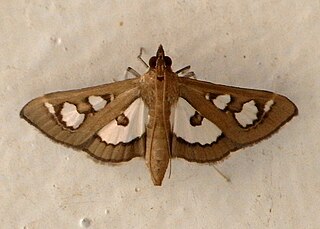Sir George Francis Hampson, 10th Baronet was an English entomologist.

Amata is a genus of tiger moths in the family Erebidae. The genus was erected by Johan Christian Fabricius in 1807.

Halone is a genus of moths in the subfamily Arctiinae from southern Asia and Australia. The genus was erected by Francis Walker in 1854.

Nacoleia is a genus of moths of the family Crambidae described by Francis Walker in 1859.

Omiodes odontosticta is a species of moth in the family Crambidae. It was first described by George Hampson in 1898 and is found Australia in Northern Territory and Queensland.
Pseudcraspedia punctata is a species of moth of the family Erebidae first described by George Hampson in 1898. It is found in Asia including Sikkim & Karnataka, Kenya, Mauritius, Réunion, Uganda and Australia.
Charltona tritonella is a moth in the family Crambidae. It was described by George Hampson in 1898. It is found in South Africa, where it has been recorded from KwaZulu-Natal and Mpumalanga.
Crambus leucoschalis is a moth in the family Crambidae. It was described by George Hampson in 1898. It is found in South Africa, where it has been recorded from Gauteng.
Pagyda schaliphora is a moth in the family Crambidae. It was described by George Hampson in 1899. It is found in Australia, where it has been recorded from Queensland.

Scoparia australiensis is a moth in the family Crambidae. It was described by George Hampson in 1899. It is found in Australia, where it has been recorded from Western Australia and Queensland.
Agrotera ignepicta is a moth in the family Crambidae. It was described by George Hampson in 1899. It is found in Australia, where it has been recorded in Queensland.
Didymostoma euphranoralis is a moth in the family Crambidae. It was described by Francis Walker in 1859. It is found in Indonesia, where it has been recorded from Sulawesi.
Filodes fulvibasalis is a moth in the family Crambidae, first described by George Hampson in 1898. It is found on the Tanimbar Islands in Indonesia and in Queensland in Australia.
Glyphodes basifascialis is a moth in the family Crambidae. It was described by George Hampson in 1899. It is found in Australia, Cameroon, the Democratic Republic of the Congo, the Seychelles, South Africa and Tanzania.
Glyphodes flavizonalis is a moth in the family Crambidae. It was described by George Hampson in 1898. It is found in Australia, where it has been recorded from Queensland.
Nacoleia obliqualis is a moth in the family Crambidae. It was described by George Hampson in 1898. It is found in Australia, where it has been recorded from Queensland.
Nosophora fulvalis is a moth in the family Crambidae. It was described by George Hampson in 1898. It is found in Papua New Guinea, where it has been recorded from Fergusson Island in the D'Entrecasteaux Islands. It is also found on Borneo and in Australia.
Syllepte ochrotozona is a moth in the family Crambidae. It was described by George Hampson in 1898. It is found in Australia, where it has been recorded from Queensland.
Syllepte hyalescens is a moth in the family Crambidae. It was described by George Hampson in 1898. It is found in Nigeria.
Tyspanodes creaghi is a moth in the family Crambidae. It was described by George Hampson in 1898. It is found on Borneo and in Papua New Guinea and Australia, where it has been recorded from Queensland.



